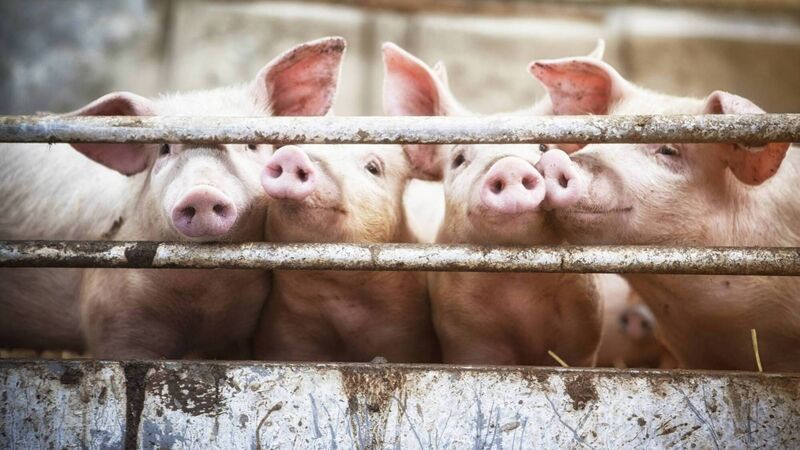Stephen Cadogan: Across Europe, countries are grappling with ways to cut farming emissions

Denmark is a major pork and dairy exporter. Its agriculture emissions make up 22.4% of the country's total carbon emissions.
A carbon tax that could cut Danish agricultural production as much as 15%, and UK farmers getting up to €1,252 per hectare for environmental land management, have re-ignited a debate about producing food versus looking after the environment.
An expert group commissioned by the Danish government proposed a farming tax of up to €101 per tonne of greenhouse gas emissions. It would reduce agricultural production by between 6% and 15%, with cattle and pig production falling by about 20% if the harshest taxation rate proposed was adopted.
Already in the UK, more than 10,000 farmers have signed up to the Sustainable Farming Incentive. The stated aim of the SFI is to produce food in an environmentally friendly manner.
But landowners could choose to enter vast amounts, or all, of their farmland into the SFI, tempted by the better chance of guaranteed income than from growing food crops and risking challenging weather and market conditions.
For example, £853 (€996) per hectare is on offer to grow winter bird food on arable and horticultural land. Farmers can get £1,072 (€1,252) per hectare for leaving the headland areas of cereal crops unharvested. And £798 (€932) per ha is on offer for growing blocks or in-field strips of flower-rich grass.
There are costs involved in carrying out these SFI actions, so the net payment UK farmers would receive is reduced. But advisers are recommending to them that it makes sense financially to include unproductive areas of their farms in higher-paying SFI actions.
They say SFI income can be a buffer against challenging food market conditions. The SFI could, in the long-run, increase the financial productivity of a farmer's least productive land.
It is particularly recommended, for example, if farmers are having persistent challenges with growing certain crops. Also, replacing break crops such as rapeseed and beans with SFI herbal ley or legume fallow actions may be a more profitable option.
British farming minister Mark Spencer has indicated his Department for Environment Food and Rural Affairs (Defra) would look at tweaking the SFI system, if there is evidence large blocks of land were being included in the scheme.
By closely monitoring the scheme, Defra could prevent it threatening UK food production, by capping the hectares of productive land included.
As for Denmark's bid to become the first country in the world to tax farming emissions (the new government in New Zealand has pushed back a proposed similar tax to the end of 2025), the latest proposed version has already been rejected by Venstre, one of Denmark’s three governing parties.
Economy minister and Venstre member Stephanie Lose said: “We are going to work on the basis of what is already on the table, with the ambition for a real green transition that will not just send jobs out of the country”.
She was referring to the 2,000 to 8,000 jobs which the Danish Expert Group on Green Tax Reform said would be lost (depending on whether the tax per tonne of emissions is €17, €50, or €101).
Denmark is a major pork and dairy exporter. It is home to the world's sixth biggest dairy company, Arla Foods, whose chief executive Peder Tuborgh told Reuters the proposals were "based on something very disappointing, namely that climate reduction can only come by reducing production".
He said new technologies had helped Arla's 9,000 farmers in Denmark, Sweden, England, Germany and the Benelux countries reduce emissions by one million tons in the last two years. "We would like to continue that journey, rather than having to shut down our production."
The carbon tax income would be redirected into new technology and research in agriculture.
Denmark has a legally-binding 2030 target of cutting greenhouse gas emissions by 70%, compared to 1990 levels. The country already has a €24.37 per tonne general rate of carbon tax, which applies to 35% of Danish emissions.
Agriculture emissions make up 22.4% of Denmark’s total carbon emissions.
"Without intervention, agriculture would account for 46% of Denmark’s emissions in 2030, noted one of the expert group, economics professor and former chairman of the Climate Council Peter Birch-Sørensen.
In 2020, there was broad political agreement to introduce a carbon tax in agriculture.
A 55-65% reduction in emissions (in 2030 compared to 1990) was the target agreed for agriculture in Denmark's Parliament in 2021.
In 2023, the Danish Council on Climate Change had found a €101 per tonne of emissions tax could achieve 45% of the 55-65% reduction. To reach the full target, it is hoped the proposed carbon tax would push individual farmers to use expected new technology (such as feed additives to reduce methane emissions), or to make structural changes such as switching from animal to plant-based farming.
The Council on Climate Change admitted at the time the number of loss-making Danish farms would increase from 25% to 45%.
The Danish Expert Group on Green Tax Reform considered emissions from livestock, fertiliser, forestry, and farming on peaty soils. Its proposals included subsidies for reforestation and for rewetting peatland.
Farmers would pay the tax on the basis of estimated emissions from their number and types of livestock and crops (it is impossible to directly measure emissions from farms). Farmers also already supply the authorities with detailed information on their use of nitrogen, on which estimates of emissions are also based.
Opponents of the planned carbon tax expressed concerns about the loss of jobs, and of agricultural competitiveness, resulting in emissions being simply moved overseas.
The Group on Green Tax Reform admitted about 3% of jobs and emissions would relocate overseas due to the tax. It said it was not possible to introduce an emissions tax on agriculture to contribute to Denmark’s long-term target to cut emissions 70% by 2030, without some job losses.


